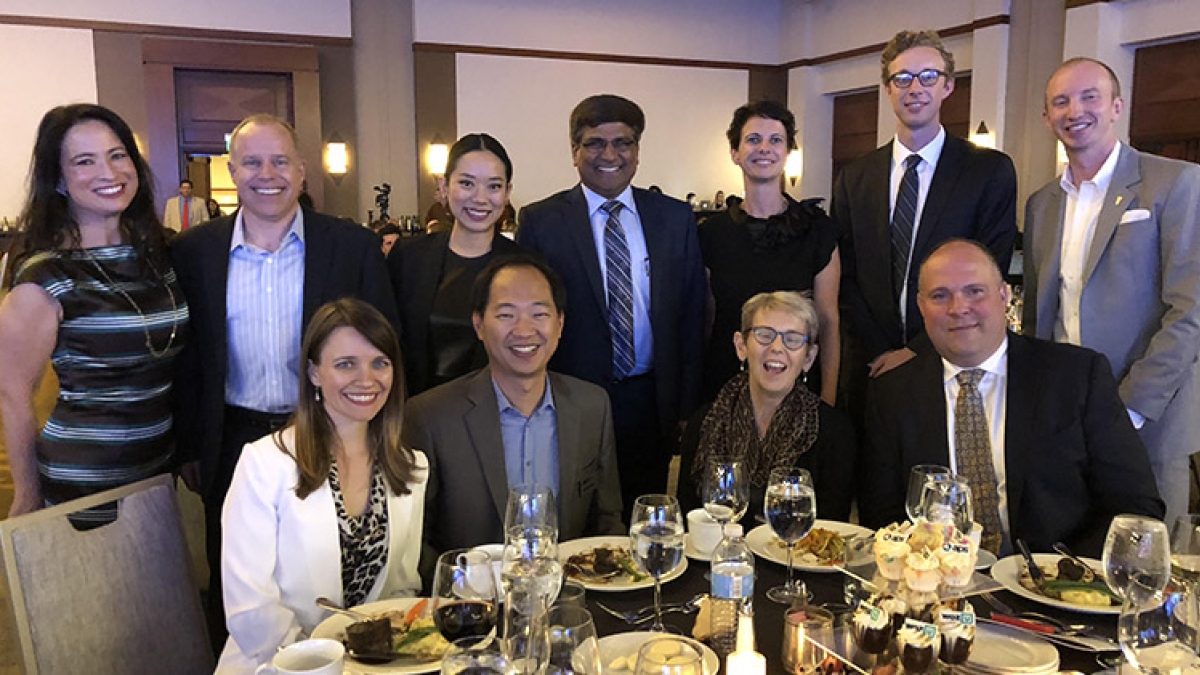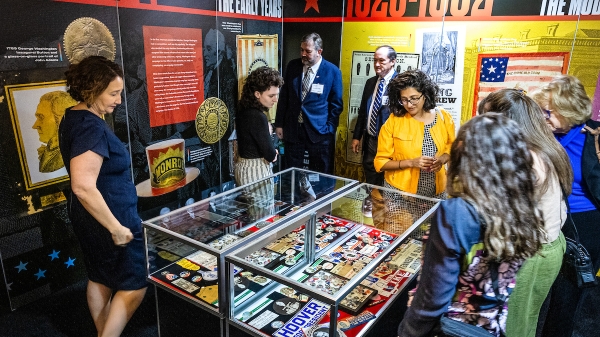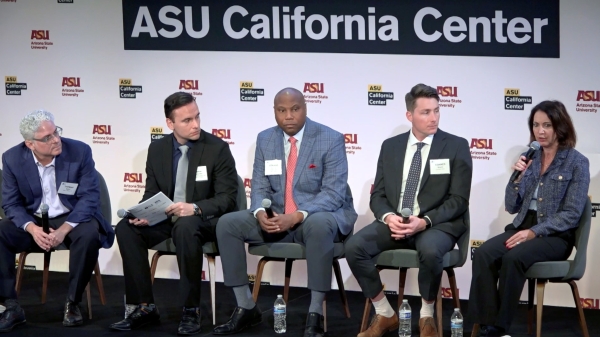Driving innovation in Arizona: A Q&A with Sethuraman Panchanathan

Sethuraman Panchanathan poses for a photo with other ASU representatives at the Institute for Automated Mobility event. Photo by Vincent Orleck
Arizona Gov. Doug Ducey signed an executive order on Oct. 11 creating the Institute for Automated Mobility, a new consortium of private-sector companies, public officials and university research faculty that will collaborate on state-of-the-art automated-vehicle research and develop a robust testing center in the state.
The institute, which includes Arizona State University, Northern Arizona University, the University of Arizona and Intel Corporation as the first private-sector founding partner, will focus on the safety, policy and science behind automated vehicles.
Gov. Ducey named Sethuraman “Panch” Panchanathan, executive vice president of the ASU Knowledge Enterprise and chief research and innovation officer, as his adviser for science and technology. Here, Panchanathan answers some questions about the institute, its origins and plans for the future of automated vehicles in Arizona.
Question: How did the idea of the Institute for Automated Mobility come about, and how was Arizona chosen as its home?
Answer: Gov. Doug Ducey started working on the concept in 2015, when he announced that he would like Arizona to be a leader in automated-vehicle technologies. That announcement set off a number of efforts to position Arizona as a place automated-vehicle companies could build their future. As a result, several companies, including Waymo and Lucid Motors, began to set up their business and build and/or test their vehicles on the roads in Arizona.
Arizona is well positioned to lead in this important space. Our strategic location also allows us to establish significant partnerships, regionally, nationally and globally.
Q: Ducey appointed you his adviser for science and technology. What are some of the opportunities that accompany this role?
A: In general, Arizona is becoming a hub for science, technology and innovation. My role as adviser to the governor provides me with the opportunity to connect companies with the fantastic universities in Arizona. I’ll advise on strategic initiatives in various fields, including data science, the internet of things, advanced manufacturing and biotechnology. Arizona’s capabilities in these focus areas, combined with expertise at the state’s public universities, will help us create an innovation ecosystem that propels us into the future.
Companies need this rich, symbiotic and synergistic relationship with universities to train the highly talented workforce that is necessary for them to be successful. The companies will also be able to partner with the universities on generating new ideas and upskilling the talent already in the workforce.
ASU companies also have the opportunity to license university-generated technologies and co-create new technologies through research partnerships. Now, we are expanding such opportunities by allowing industry members to tap into university research expertise.
Most companies want to engage in a dynamic ecosystem with other companies and their competitors, so they can help each other coevolve. A rising tide lifts all boats. We have an opening to create a highly synergistic ecosystem where everybody prospers.
Q: How do the mission and values of the institute align with ASU’s unique approach to cross-sector and public-private collaborations?
A: The Institute for Automated Mobility is bringing together a number of disciplines to advance these technologies in the state. Arizona State University has fostered an environment where people naturally work across disciplines and institutions to transform grand challenges into grand opportunities. The future of automated vehicles is not focused solely on science, technology and engineering. We must ensure safety in the human-machine interactions by evolving robust policies, legal and ethical frameworks for operation. The Institute for Automated Mobility seeks to bring people with different perspectives and backgrounds to find creative solutions.
Q: From the perspective of an expert in the field, how does the institute help advance the future of smart cities?
A: Automated mobility is one component of the multifaceted smart city concept. It is an exemplar of what a smart city can be — the unification of technology and infrastructure to improve the human experience. The innovations and implementations from IAM have far reaching impact in the context of the design and development of smart cities. For example, the companies that will be in the supply chain for automated mobility can also serve some of the needs of a smart city. I find it very exciting that the institute can be an exemplar on how humans and machines can work together to create an accessible and equitable environment for the citizens of Arizona.
Q: How are Arizona’s public universities helping shape the mindset of innovation in the state?
A: Major metropolitan cities in the U.S. with strong research universities have prospered economically because of the strong science and technology ideas, talent and partnerships between academia and industry. Examples include San Francisco, Boston, Seattle, Austin and Atlanta. Arizona is again well-positioned because of its strong research universities and quality talent delivering solutions at scale. Phoenix and Tucson exemplify an intentional approach to advancing the spirit of science and technology in our cities and leveraging the strengths of both companies and universities to support each other in a symbiotic collaboration.
Shaping the innovative mindset at Arizona’s public universities begins with practicing innovation. We are inspiring students to think innovatively by providing them with a platform to display their creativity in solving complex problems. This is exceedingly important for the future of Arizona and the future of our planet, to encourage a more innovative, solution-oriented citizenry.
Written by Madison Arnold
More Law, journalism and politics

Exhibit uses rare memorabilia to illustrate evolution of US presidential campaigns
After one of the most contentious elections in history, a new museum exhibit offers a historical perspective on the centuries-old…

TechTainment conference explores the crossroads of law, technology, entertainment
What protections do writers, actors, producers and others have from AI? Will changing laws around name, image and likeness (…

How to watch an election
Every election night, adrenaline pumps through newsrooms across the country as journalists take the pulse of democracy. We…

